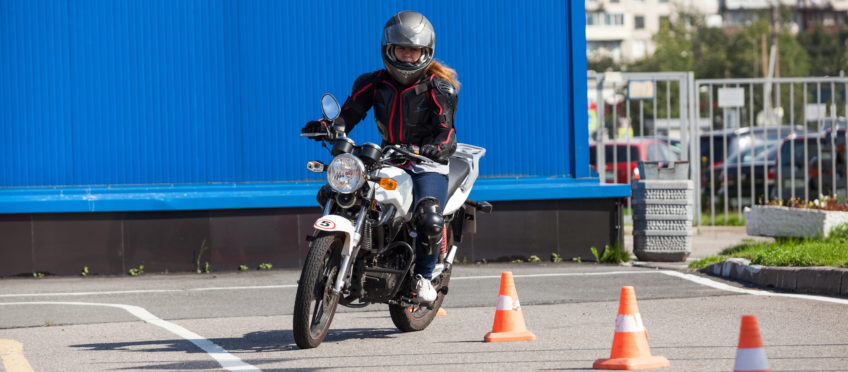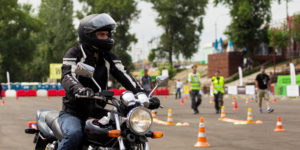Which rider is a prime candidate for Advanced Rider Training?
- Rider 1 took the basic rider course and has been riding on the road for a few years without incident.
- Rider 2 has ridden for decades and tens, maybe hundreds of thousands of kilometers, also without incident.
- Rider 3 has a new motorcycle, different in engine size, weight, and body position.
The answer is all three. We all need regular skills upgrades. The best riders train continuously. It’s an investment in yourself, and a sport you love. Skills get rusty when they’re idle, like during the four to six months our motorcycles are parked for the winter. Skills can also deteriorate with time if they’re not refreshed regularly.
Invariably, riders who complete advanced training come away astonished at what they didn’t know, how much they’ve learned, and how much their riding has improved. (M2Exit courses are not considered technical skills training.)
A variety of programs, designed specifically to improve on-road skills, are available throughout Ontario. We’ve listed four of them, each with a unique approach. All are done on your own motorcycle.
Plan a weekend, enlist some friends, and upgrade your skills. You’ll come away from a better rider, have a lot of fun, and advanced Rider Training our family will thank you!
Rider Training Institute
RTI has two advanced skills courses, designed to meet different rider needs.
Technical Skills
This is a full-day course designed for riders with a full M or M2 who want to get comfortable on their motorcycle. Many are returning after a prolonged absence from riding. Others have new bikes with a different weight, suspension, and riding position than what they’re used to. These riders want to understand how their new bike is going to react and how to ride it proficiently.
“Holding the course in a parking lot, in a controlled environment, allows riders to understand how their bike is going to react in certain situations,” says Sharron St. Croix, Executive Director. “They can then easily transfer their skills to the road. No matter what level you enter at, you leave with more skills. ”
Since it’s harder to control your bike at lower speeds, the morning focuses on sharpening slow speed riding skills. An extra segment reviews riding gear and packing for touring.
The afternoon focuses on collision avoidance, including braking exercises, and curves. Students learn faster braking than what’s taught in the basic course, how their bike reacts with front and rear brakes, and the appropriate circumstances under which to use each one.
The curves section covers related speed judgment, braking and down-shifting, correct lines of travel, and how to respond to obstacles.
An obstacle course, requiring all the skills they touched on, wraps up the day.
Course locations: North York/Scarborough and Guelph.
Roadworthy Skills
New this year, Roadworthy Skills meets the needs of those with an M2 or M license who want to increase their skill level, often in preparation for group riding.
Participants undergo a skills refresher in the morning in RTI’s parking lot, including a review of how to handle their motorcycle.
The afternoon features a group ride to a local scenic destination and tips on group riding. “They return knowing more about local roads, and a lot more confident with their riding,” says St. Croix.
Course locations: North York/Scarborough, Guelph, and Oakville.
RTI offers private lessons for any of their courses, in any of their locations across Ontario, on RTI bikes or participant’s motorcycle. RTI will also assist riders on their own bikes at more locations. Returning students get RTI’s loyalty price.
Contact RTI through their website or by calling 416-516-6151 or 1-866-876-1551.
Georgian College
“There’s always value in having a professional assess your skills,” says Jenn Martin, Coordinating Chief Instructor in the Motorcycle Program at Georgian College. “We all get rusty and we don’t realize our actions are putting us in hazardous situations.”
Enhance Your Riding
Rider Development Phase 1
Students bring their own motorcycles for Phase 1, three hours spent on in the parking lot, cruising at lower speeds, and learning techniques for maneuvering and being in control at those speeds.
Rider Development Phase 2
Also done over three hours, Phase 2 is done at higher speeds, honing collision avoidance techniques, techniques you should not be using on an ongoing basis but need to continuously practice, according to Martin.
Experienced Rider Course
This six-hour program teaches advanced tips and techniques to help you own the road. Beginning with sharpening skills in the parking lot, instructors then take riders on a pre-determined route, with live coaching, and immediate feedback on riding techniques. Lessons include U-turns on narrow roads, advanced curves, and dealing with the unexpected.
Groups are small, which allows instructors the flexibility to cater to individual needs and provide the specific training students are looking for.
“You don’t always know what you need to work on,” says Martin. “Go in with an open mind and ask questions.”
Students must hold an M2 or M license and provide a properly licensed and insured roadworthy motorcycle. Georgian also offers private lessons on your own bike, at any of their locations.
Contact Georgian at 705-722-1511
Sharp Rider Motorcycle Training
Sharp Rider teaches Total Control techniques, a methodology designed by former racer Lee Parks.
Based on the premise that knowing why something works facilitate learning how to do it, courses are a combination of classes and parking lot exercises.
Total Control’s integrative approach covers the physical, mental, and mechanical aspects of riding. The mental aspect deals with fear, concentration, and the right attitude. “That momentary pause,” says Donna Skinner, one of the owners of Sharp Rider and the Lead ARC (Advanced Rider Clinic) Instructor, “is the five seconds that could have saved your life.
“Learning how to concentrate in the here and now,” she says, “helps you understand how to change your process and make your brain work properly on a motorcycle.”
Total Control’s mechanical aspect focuses on managing and maximizing your traction at all times. Understanding how your suspension works to keep you stable, whether you’re in a straight line or in corners, is a huge part of keeping yourself upright.
Their biomechanical approach emphasizes “economy of movement to reduce rider fatigue and provides more precise control and safety.”
“If you get the right techniques and build them into your muscle memory, “ says Skinner, “your body reacts appropriately under pressure, and that’s key to survival.”
Intermediate Riding Clinic
Designed for riders who want to take their skills to the next level, this course teaches throttle control, controlled braking techniques, collision avoidance maneuvers, road-speed turning, low-speed turning, and line selection.
Total Control Level 1
Using a combination of classroom and parking lot techniques, this course builds skills on a step-by-step basis. It covers traction management, mental state, throttle control, trail-braking, body positioning, and an understanding of motorcycle suspension.
Total Control Level 2
Building on Level 1, Level 2 moves riders “from proficiency to mastery.” Also using a combination of classroom and parking lot exercises, topics covered include riding psychology, speed shifting, quick stops, decreasing radius turns, and chassis set-up.
Total Control requires students to have 5,000 kilometres of riding experience before taking Total Control Level 1 and 2. There is no minimum experience required for the Intermediate program. Courses are held in Mississauga and Lakefield.
Contact them through Sharp Rider Motorcycle Training or 647-885-1801.
Humber College
Precision Riding
Humber’s customized program is designed specifically for groups with a minimum of eight to ten riders.
Since most accidents happen below 30kph, the ability to maneuver your motorcycle with precision and confidence at slow speed is an essential skill. It takes practice and requires specific techniques to develop with proficiency.
“We can do any type of advanced rider training,” says Andy Hertel, Program Manager, Motorcycle Rider Training. “We have access to police officers, and people who train police officers to bring those skills to you.”
Courses are tailored to individual skill level and emphasize specific skills, depending on the needs of the group. Within any one exercise instructors can add challenges for more experienced riders.
During the six-hour Precision Riding program, riders build their skills over a series of progressive exercises including slow riding, cone weave, riding in a tight circle, offset cone weave, U-turns, and intersection tactics. The intersection brings together all the key skills of torque, leaning the motorcycle, change of direction and vision control.
Students should have completed a basic motorcycle rider-training course and have several thousand kilometers of street riding experience.
To learn more and book your group, contact Andy Hertel at AndyHertel@humber.ca.










Does completing this level of course reduCe insurance premium?